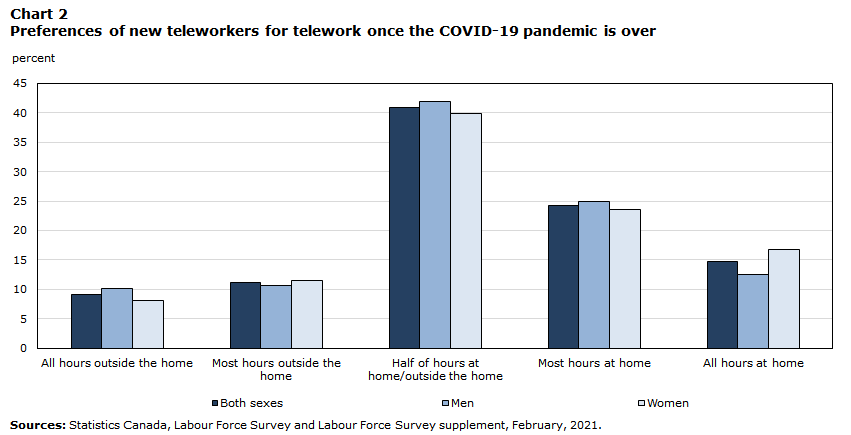Working at Home in Time of COVID-19 — Positive and Negative Effects in Canada
Since the start of the pandemic, many people working across Canada have had to adapt to a new way of doing business. Some were frontline workers who put their lives on the line every day to ensure Canadians’ safety. Approximately 30% of Canadian[1] workers were sent home to try to further control the spread of the virus. New ways of working began to apply as of April 2020. It’s been over a year now. What has been learned since then? That is what we are going to try to unpack by looking at five issues surrounding teleworking over the past year in Canada: productivity; family; flexibility; environment and preference.
Productivity
Canadian workers with office jobs, now finding themselves working from home, never imagined that they would find themselves in this situation. Some did not have the necessary equipment — a separate room that could be used as an office, a computer, a printer, etcetera. They had to adapt one day at a time in order to remain as productive as they had been in their previous work environment. Productivity is now measured more by the amount of work done per day, not by the amount done per hour.
According to Statistics Canada, 90% of teleworkers reported being as productive at home as they were in their previous workplace. Only 10% of new teleworkers reported doing less work per hour from home than at their usual place of work. All statistics are broken down by industry and by the characteristics of individual Canadian workers.
One in five teleworking Canadians reported a lack of interaction with colleagues as an obstacle to working more, according to Statistics Canada reports. Other teleworkers mentioned that caring for children or other family members was a barrier to productivity. Yet others faced a variety of challenges: lack of access to work-related information or devices; having to work harder to get things done; having an inappropriate workspace, or having difficulty with Internet speed.

Family
When it comes to family, there are two main factors affecting productivity for both sexes: caring for children or a family member, and domestic violence.
First, the arrival of the pandemic in Canada was a shock to everyone with an established rhythm of life and a routine designed to achieve a good work/family life balance. When schools closed, some parents found themselves working from home, and the imbalance in their lives became pronounced. In the early days, daycare support was no longer available, so parents had to switch to online home schooling. Today, schools are reopening, as are daycares. However, if your child has symptoms that may indicate COVID-19, you must fetch him or her from school and arrange for testing as soon as possible. If symptoms are present, the next step is to self-isolate and follow procedures.
Parenting during a pandemic is stressful! The stakes are high. For some, telecommuting has not been an issue, but for others, negotiations with an employer have been difficult. School vacation has just ended. Some telecommuters have had no choice but to be with their child 24/7. Staying focused while simultaneously working and minding a child is a challenge. It is also important to let children know what is going on. Communication is important — telling a child why he or she can no longer go to school or see friends. A 13-year-old does not require the same kind of supervision as a 3-year-old. However, teenagers are adverse to being separated from friends. The daily routine is difficult for everyone. Some workers took days off to organize around parenting, especially when home-schooling. Can we really call this a day off? This is not relaxing. But one is not alone! Many sources of advice can be found on the Web. Here are some:
- https://lifeworks.com/en/resource/how-manage-your-work-and-childcare-when-schools-are-closed
- Home-schooling your kids during COVID-19: Find the right fit for your family (cpacanada.ca)
- Pandemic Parenting: Tips for Parents and Caregivers : Ottawa-Carleton, ON : eMentalHealth.ca
Restrictions, curfews, home-schooling, and other stresses resulted in domestic violence in Canada. The resources needed to address such problems are difficult to access during a pandemic. Family violence is becoming more severe. Because victims live 24/7 with their abusers, it is difficult for them to find the right moment to reach out for help. It is also easier to mask the problem when at home, away from colleagues. There is a new hand sign that has become recognized as a call for help: put a thumb in the palm of the hand and close the fist. If you are witness to this call for help, stay calm so as not to alarm the aggressor, and call the police. Be vigilant. You can save lives.
Flexibility
As you may have noticed, telecommuting topics are interconnected. Working productively from home can sometimes be difficult when children are present. This makes flexibility an important topic for Canadian workers living a new reality. According to a telecommuting survey, 93% of respondents would stay with their employer longer if they had flexibility in where to work and when. However, 54% would leave their company if flexibility in work schedule and location were not available.[2]
People have adapted to a new way of life. They control their schedule and respect their boss’s deadlines. It is difficult to plan during a pandemic. By offering flexibility, an employer is recognizing the challenges for the worker. It is also worth noting the study by Nicholas Bloom and graduate student James Liang, co-founder of the Chinese travel website, Ctrip. This showed that when employees can choose to work from home, there are huge productivity gains[3]. It has even been found that the majority of workers with more control over their schedules work longer.
Environment
Flexibility and environment are two very similar topics. In fact, the environment is seen as an element dependent on flexibility. We usually talk about working from home or working remotely. Is having a job in Ottawa and working in Vancouver possible? Having a job in Vancouver and working in another country? These are questions that Canadian workers are considering.
For some, it is city versus country. What is the advantage of having a house in the city centre that costs three times as much as a house in a village? Driving distance and traffic are no longer issues for workers. On the other hand, teleworkers who used to have an office in the city and who lived in the country, in some cases, are experiencing Internet problems. High-speed Internet is not available to every village in Canada, or in the world, and this can cause serious problems for video meetings, web searches or other demands requiring high network speed.
Preference
In terms of preference, 80% of employees already teleworking in Canada indicated that they would like to work at least half their time at home once the pandemic is over.[4]

For employers, there are important conditions that must be met in order to allow staff to telework in the long term. A worker must be as productive at home as in the office and must express a strong preference for teleworking once the COVID-19 pandemic is over. In addition, employers must be willing and able to accommodate employee demand to telework. For employees, there are several benefits, including the following:
- Management of one’s schedule;
- Reduced daily expenses for the company;
- Reduction of stress related to transportation (and time spent commuting);
- Autonomy and management of rest time;
- Reduced interruptions in the office, and
- Various others.[5]
Several advantages and disadvantages come with telecommuting. The technology is now adapted to work from home, which also leads to “hyperconnectivity”, or being too often connected. Here are some examples of the negative aspects of telecommuting:
- Risk of isolation;
- Imbalance between professional and personal life;
- Stress related to the objectives;
- Demotivation due to monotony;
- Lack of human contact;
- Poor time management;
- Mental overload;
- Distractions from the family;
- Risk of working too much;
- Fear of being “forgotten” by the company.[6]
All adaptation is based on the health and safety of Canadians. Since the arrival of the vaccine, activities are slowly resuming. In addition, some 61% of respondents to a survey want their company to require vaccination against COVID-19 before they physically return to the office. However, there are two sides to the coin: the employees’ and the employers’. The two sides have views that can sometimes be aligned, or be opposite. Eventually, there will be a transition following more than a year of telecommuting. What will be the best balance for Canadian workers? To be continued …
For more statistics on working from home during the pandemic:
[fusion_button link=”https://www150.statcan.gc.ca/n1/daily-quotidien/210804/dq210804b-eng.htm” text_transform=”” title=”” target=”_self” link_attributes=”” alignment=”” modal=”” hide_on_mobile=”small-visibility,medium-visibility,large-visibility” class=”” id=”” color=”default” button_gradient_top_color=”” button_gradient_bottom_color=”” button_gradient_top_color_hover=”” button_gradient_bottom_color_hover=”” accent_color=”” accent_hover_color=”” type=”” bevel_color=”” border_width=”” border_radius=”” border_color=”” border_hover_color=”” size=”” stretch=”default” icon=”” icon_position=”left” icon_divider=”no” animation_type=”” animation_direction=”left” animation_speed=”0.3″ animation_offset=””]CLICK HERE[/fusion_button]
[1] https://connect.qub.ca/connexion?app_name=&client_id=5t2k497d4e9ji1se775harj1g4&identification=false&next=%2Fauthorize%3Fresponse_type%3Dcode%26subscription_flow%3Dfalse%26client_id%3D5t2k497d4e9ji1se775harj1g4%26redirect_uri%3Dhttps%3A%2F%2Fwww.journaldemontreal.com%2Fconnect-callback-login%26state%3DLzIwMjEvMDgvMDQvcHJlcy1kdW4tY2FuYWRpZW4tc3VyLXRyb2lzLWVuLXRlbGV0cmF2YWls%26theme%3DJDM%26app_name%3D&redirect_uri=https%3A%2F%2Fwww.journaldemontreal.com%2Fconnect-callback-login&response_type=code&state=LzIwMjEvMDgvMDQvcHJlcy1kdW4tY2FuYWRpZW4tc3VyLXRyb2lzLWVuLXRlbGV0cmF2YWls&subscription_flow=false&theme=JDM”&tracking_object=%7B%22app%22%3A%7B%22platform%22%3A%22web%22%7D%2C%22brand%22%3A%22JDM%22%2C%22user%22%3A%7B%22gaClientId%22%3Anull%7D%2C%22customValue%22%3Anull%7D&subscription_form=simple&prompt=none
[2] https://www.ledevoir.com/economie/613068/coronavirus-les-canadiens-veulent-conserver-la-flexibilite-du-teletravail
[3] https://hbr.org/2014/01/to-raise-productivity-let-more-employees-work-from-home
[4] https://www150.statcan.gc.ca/n1/pub/45-28-0001/2021001/article/00012-fra.htm
[5] https://www.noovomoi.ca/vivre/sante/article.avantages-dangers-teletravail.1.12782873.html
[6] https://www.noovomoi.ca/vivre/sante/article.avantages-dangers-teletravail.1.12782873.html
